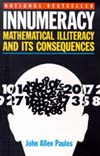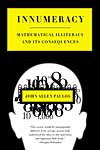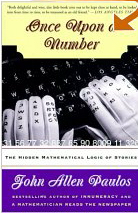John Allen Paulos: a leader in showing the public the problem of innumeracy. His Home Page is a treasure! He is a professor of mathematics at Temple University and the author of several other popular books on mathematics. He is a regular contributor to national publications, including The New York Times and Newsweek.
Innumeracy: Mathematical Illiteracy and Its Consequences (1988)
 Table of Contents
Table of Contents
- Examples and Principles
- Probability and Coincidence
- Pseudoscience
- Whence Innumeracy?
- Statistics, Trade-Offs, and Society
Introduction
Close
Amazon Review:
“Sprinkling his discussion of numbers and probabilities with quirky stories and anecdotes, Paulos ranges freely over many aspects of modern life, from contested elections to sports stats, from stock scams and newspaper psychics to diet and medical claims, sex discrimination, insurance, lotteries, and drug testing. Readers of Innumeracy will be rewarded with scores of astonishing facts, a fistful of powerful ideas, and, most important, a clearer, more quantitative way of looking at their world.”
Back Cover:
“The innumerate will surely profit from this entertaining book.” — The New York Times Book Review
“Why do even well-educated people understand so little about mathematics? And what are the costs of our innumeracy? John Allen Paulos, in his celebrated bestseller first published in 1988, argues that our inability to deal rationally with very large numbers and the probabilities associated with them results in misinformed governmental policies, confused personal decisions, and an increased susceptibility to pseudoscience of all kinds. Innumeracy lets us know what we're missing, and how we can do something about it.” [Publisher]
“Our society would be unimaginably different if the average person truly understood the ideas in this marvelous and important little book.” — Douglas Hofstadter
 Inside Front Cover: Praise for Innumeracy
Inside Front Cover: Praise for Innumeracy
“Paulos involves the reader in the fun of numeracy in his entertaining, thought-provoking book.” — Christian Science Monitor
“[John Allen Paulos] takes us a couple of steps closer to numeracy, and it all in all an enlightening place to be.” — The New York Times
“Paulos gives us a readable romp across a varied landscape. … [He] makes numbers, probability and statistics perform like so many trained seals for the reader's entertainment and enlightenment.” — The Philadelphia Inquirer
Reviews (from Paulos website)
“To combat [innumeracy] John Allen Paulos has concocted the perfect vaccine: this book, which is in many ways better than an entire high school math education! Our society would be unimaginably different if the average person truly understood the ideas in this marvelous and important book. It is probably hopelessly optimistic to dream this way, but I hope that Innumeracy might help launch a revolution in math education that would do for innumeracy what Sabin and Salk did for polio.” — Douglas Hofstadter, author of Godel, Escher, and Bach
This elegant survival manual is brief, witty, and full of practical applications. — Stefan Kanfer, Time Magazine
Like carrying on a conversation with an engaging, articulate math whiz who easily shifts from the profound to the funny. — Christopher Farrell, Business Week
Paulos makes numbers, probability, and statistics perform like so many trained seals for the reader's entertainment and enlightenment. — Jon Van, Chicago Tribune
The innumerate will surely profit from this entertaining book. — Morris Kline, New York Times Book Review
This admirable little book is only 135 pages long. You can read it in 2 hours. Chances are that they could be among the most enlightening and even profitable 120 minutes you ever spent. — Henry Kisor, Chicago Sun-Times
The world, as seen by Paulos, is less mysterious, yet somehow more elegant, less magical, yet more wonderful. So many apparently strange events do, in fact, become all the more magnificent in their not-so-fearful symmetry. — Arthur Salm, San Diego Tribune
He takes us a couple of steps closer to numeracy, and it is all in all an enlightening place to be. — Christopher Lehman-Haupt, New York Times
One wonders why no one ever explained it this way before. — Sheila Tobias, author of Overcoming Math Anxiety
Innumeracy would improve the quality of thinking of virtually anyone. — Isaac Asimov
A Mathematician Reads the Newspaper (1995)
 Table of Contents
Table of Contents
- Politics, Economics and the Nation
- Local Business and Social Issues
- Lifestyle, Spin and Soft News
- Science, Medicine and the Environment
- Food, Book Reviews, Sports and Obituaries
Introduction
Reviews (from Paulos web site):
But the dirty secret about the media's contribution to American “Innumeracy,” first examined in a delightful book by that title by John Allen Paulos, is about to be revealed in his sequel, A Mathematician Reads the Newspaper. — Max Frankel, New York Times
This is press criticism, but not of the usual kind. … This is press criticism of the sort that George Orwell had in mind when he observed that what's important isn't news, and what's news isn't important. … This is a subversive book. Paulos argues that the world is so complex that it cannot be accurately described, much less manipulated. … a wise and thoughtful book, which skewers much of what everyone knows to be true. — Lee Dembart, Los Angeles Times
… this book should be mandatory reading for every journalist—as well as the readers, viewers and former tutors they supposedly serve. — Robert Matthews, New Scientist
It would be great to have John Allen Paulos living next door. Every morning when you read the paper and came across some story that didn't seem quite right—that had the faint odor of illogic hovering about it—you could just lean out the window and shout, “Jack! Get the hell over here!” … Paulos, who wrote the bestseller Innumeracy (the mathematical equivalent of illiteracy), has now written a fun, spunky, wise little book that would be helpful to both the consumers of the news and its purveyors. — Joel Achenbach, Washington Post
Even better, Paulos' wit and humor—admirably displayed in Innumeracy—are in top form. His irreverent and pointed comments entertain as well as educate. Though Paulos writes about a bewildering number of topics, he has something fresh and interesting to say about each. — Charles Seife, Philadelphia Inquirer
This book will bring a great deal of pleasure to many—as it did to the reviewer. It is full of fun, full of information, full of insights. — Peter Hilton, American Mathematical Monthly
Although the combination of math and newspapers sounds uniquely unappetizing, John Allen Paulos creates a truly thought-provoking book from that mixture. — Best Bet, USA Today
In his new book, the mathematician John Allen Paulos continues his witty crusade against mathematical illiteracy … Mr. Paulos's little essay explaining the Banzhaf power index and how it relates to Lani Guinier's ideas about empowering minorities is itself worth the price of the book. — Richard Bernstein, New York Times
As intriguing as these examples may be, Paulos' book is much more than an assortment of helpful hints for news readers. As a lifelong fan of newspapers, Paulos provides a wide-ranging collection of musings on mathematics, the media and life itself. — Jon Van, Chicago Tribune
To the rescue comes our hero John Allen Paulos, that mysterious masked mathematician on a white horse, with his new book, “A Mathematician Reads the Newspaper.” … If paranoia could be cured by math, Paulos would be the Jonas Salk of the disease. His dissection of conspiracy theories is delicious. — Molly Ivins, Syndicated Columnist
Paulos uses his considerable talents and a breezy style to discuss many ways to apply simple, or at least simply explained, mathematics and logic to analyze the contents of the newspaper. … the book is a compendium of unusually sound advice, which, if widely read and understood, could improve a lot more for us than the way we read the newspaper. — Journal of the American Medical Association
… A Mathematician Reads the Newspaper is irresistible. — Rudy Rucker, Scientific American
Once Upon A Number: The Hidden Mathematical Logic of Stories (1998)
 Table of Contents
Table of Contents
- Between Stories and Statistics
- Between Subjective Viewpoints and Interpersonal Probability
- Between Informal Discourse and Logic
- Between Meaning and Information
- Bridging the Gap
Introduction
Editorial Reviews
Amazon.com: Mathematician John Allen Paulos bravely bridges the scientific and literary cultures with this amusing, enlightening look at numbers and stories. If you think those two things go together like a “horse and a paperclip,” as Allen wryly observes, you only have to look at phenomena like the Bible codes, the stock market's ups and downs, and the Clinton sex scandal to begin to understand the hidden bonds between them. Put simply, mathematics can describe everything that happens, and everything that happens contextualizes mathematics. In demonstrating this, Paulos continues the noble numeracy crusade he began with A Mathematician Reads the Newspaper and Innumeracy. Perhaps the most compelling thought experiments in the book are those of the statistics of stereotyping and race relations. Paulos shows, mathematically, that minority status makes achieving equality extraordinarily difficult.
If you want to keep hold of your comfortable worldview, don't read Once Upon a Number. But you'll be missing out on an unforgettable reminder of what chance, coincidence, and odds really mean, along with several valuable life lessons that may help you understand lost socks, racism, and mistaken identity. — Therese Littleton [This text refers to an out of print or unavailable edition of this title.]
From Publishers Weekly: “This book is not concerned with the history of great theorems, but with bridging, or at least clarifying, some of the gaps between formal mathematics and its applications.” This statement of purpose, more clearly than the book's title, best sums up Paulos's goals in his latest work. Paulos (Innumeracy) insists that statistics cannot be disconnected from the stories—or narrative contexts—that attach them to the complexities of the world. He demonstrates this idea through examples including recent controversies over birth order and the so-called Bible codes. Before we can agree on the meaning of statistics about birth order, he contends, we must agree on what the terms involved mean. Is an only child the same as a first-born? What about a baby born to a large family but then adopted by a childless couple? Paulos turns to the Bible codes to demonstrate that it is the stories we tell about seemingly improbable coincidences, rather than the mathematics involved, that make them compelling. Not only are most seeming coincidences of “stunning insignificance,” he explains, but in the case of textual analysis, they are easy to generate. Paulos shows this by easily locating the names “Bill” and “Monica” in the U.S. Constitution. The author may occasionally frustrate readers with an indirect approach, and some sections read more like trenchant observations than argument, but his sense of humor is always quite winning. Paulos's insightful and amusing observations on how the truths discovered through mathematics should be applied to our everyday lives will appeal to an audience beyond math and science enthusiasts. Copyright 1998 Reed Business Information, Inc. [This text refers to an out of print or unavailable edition of this title.]
Irreligion: A Mathematician Explains Why the Arguments for God Just Don't Add Up (2007)
 From Publishers Weekly:
From Publishers Weekly:
Few of the recent books on atheism have been worth reading just for wit and style, but this is one of them: Paulos is truly funny. Despite the title, the Temple University math professor doesn't actually discuss mathematics much, which will be a relief to any numerically challenged readers who felt intimidated by his previous book Innumeracy: Mathematical Illiteracy and Its Consequences. In this short primer (just the gist with an occasional jest), Paulos tackles 12 of the most common arguments for God, including the argument from design, the idea that a moral universality points to a creator God, the notion of first causes and the argument from coincidence, among others. Along the way, he intersperses irreverent and entertaining little chapterlets that contain his musings on various subjects, including a rather hilarious imagined IM exchange with God that slyly parodies Neale Donald Walsch's Conversations with God. Why does solemnity tend to infect almost all discussions of religion? Paulos asks, clearly bemoaning the dearth of humor. This little book goes a long way toward correcting the problem, and provides both atheists and religious apologists some digestible food for thought along the way. (Jan. 3) Copyright © Reed Business Information, a division of Reed Elsevier Inc. All rights reserved.
Reviews:
“He’s done it again. John Allen Paulos has written a charming book that takes you on a sojourn of flawless logic, with simple and clear examples drawn from math, science, and pop culture. At journey’s end, Paulos has left you with plenty to think about, whether you are religious, irreligious, or anything in between.” —Neil deGrasse Tyson, astrophysicist, American Museum of Natural History and author of Death By Black Hole and Other Cosmic Quandaries “For years John Allen Paulos has been our guide for reading newspapers, playing the stock market, and understanding what all those graphs and charts and formulas really mean. No one knows how to dissect an argument better than Paulos. Now he has turned his rapier wit to the grandest question of them all: is there a God? Those who are religious skeptics will find in Paulos’s analysis new ways of looking at both old and new arguments, and those who believe that God’s existence can be proven through science, reason, and logic will have to answer to this mathematician’s penetrating analysis.” — Michael Shermer, Publisher of Skeptic magazine, monthly columnist for Scientific American, and the author of How We Believe, The Science of Good and Evil, and Why Darwin Matters
“Using the methods of mathematics, reason and logic, Paulos wrestles religious belief systems to the ground and in the process proves he is as good a writer as he is a mathematician. The book is short, to the point and humorous, and God knows, this subject could use more humor.” — Joan Konner, Dean Emerita of the Columbia Graduate School of Journalism and editor of The Atheist’s Bible
“Another virtuoso performance from a master in the use of mathematics to explore the conundrums and mysteries of everyday life.” — Sylvia Nasar, author of A Beautiful Mind
“John Allen Paulos has done us all a great service. Irreligion is an elegant and timely response to the manifold ignorance that still goes by the name of 'faith' in the 21st century.” — Sam Harris, author of the New York Times best sellers The End of Faith and Letter to a Christian
Video: Beyond Belief 2007 (SE25-35) John Allen Paulos 1-4
Other books by Paulos:
- Beyond Numeracy (1992)
- I Think, Therefore I Laugh (2000)
- A Mathematician Plays The Stock Market (2003) (2004)
- Mathematics and Humor: A Study of the Logic of Humor (1982)

